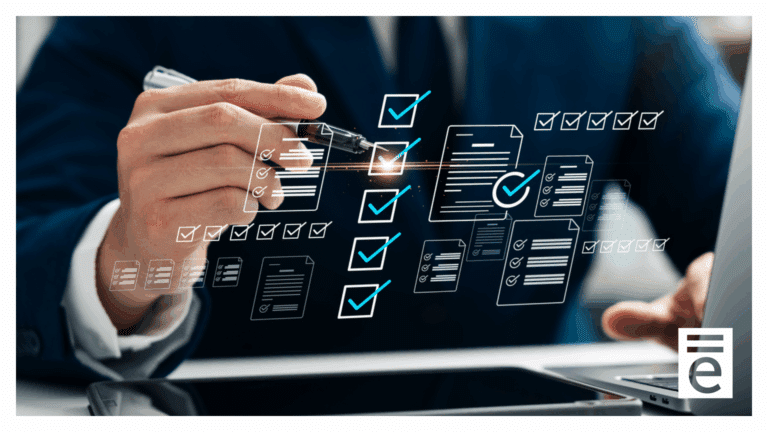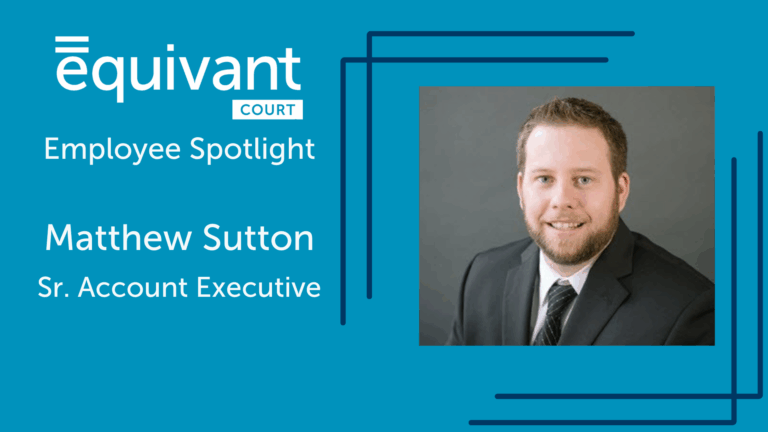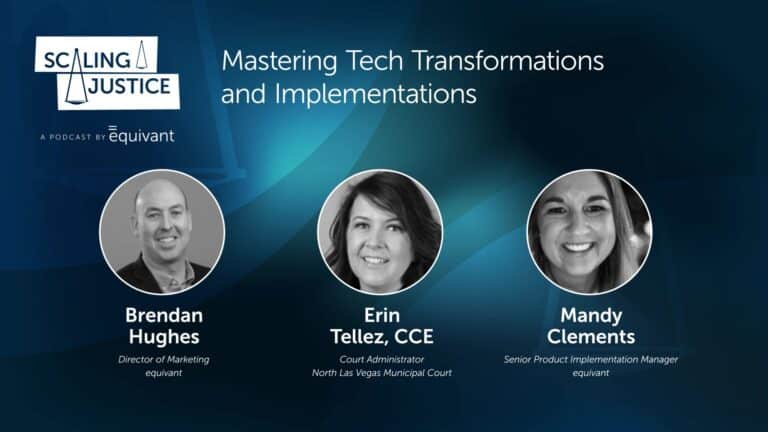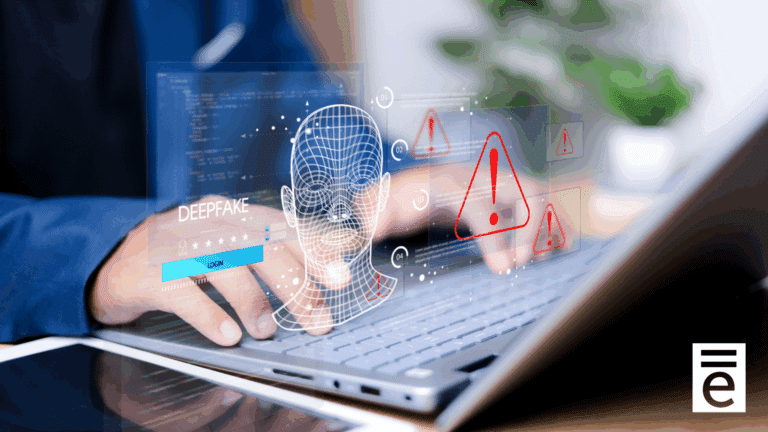Scaling Justice • An equivant podcast
Judicial Officers have a lot on their plate! While technology constantly evolves, we still see many Courts and Judicial Officers using legacy systems and applications that contribute to inefficient processes and caseflow. Public servants working in the justice industry are quickly realizing this isn’t sustainable. In this episode of Scaling Justice, special guests Honorable Jeffrey Adler (Municipal Court Judge in Girard, OH), Honorable William Montgomery (Alaska Superior Court Judge for the 4th District), and Stacey Marz (Administrative Director for the Alaska Court System) explore the tech revolution happening in the justice industry and talk about how they are navigating and leading technological change in the legal world.
Watch now:
Stream Audio Version on Simplecast.
Scaling Justice Podcast Transcript
How Judges Leverage Technology in Their Courts to Improve Efficiency Podcast
Brendan Hughes: Hello and welcome to Scaling Justice, a video podcast by equivant that operates at the forefront of the justice space. I’m Brendan Hughes, director of marketing at equivant. All of us here at equivant are dedicated to delivering innovative solutions to simplify justice and to help build more efficient and effective justice agencies nationwide.
I am excited to dive into today’s topic on how judges are leveraging technology to create more efficient courtrooms, and I’m excited for a couple of reasons. First, just the quality of the panel of guests that I have joining me today, which I’ll introduce in a moment. I’m also excited because I think courts, the judicial system as a whole is quickly undergoing a large technology shift, almost a tech revolution, and much of the judiciary is on legacy systems and applications and it really isn’t sustainable in today’s world. The public, staff, court admins, judges, everyone associated with the courts are accustomed to newer technology and are more tech-savvy than often what courts are currently using day to day.
And so that’s why I think this makes this conversation so timely and I’m excited to have our guests here to talk about it. We’ll discuss a little bit of where courts were tech-wise, some of the pain points where we are now, what is working, and then maybe a little bit of what’s to come in the future. All right, so now a quick introduction to my panelists. First, the Honorable Jeffrey Adler. He’s the municipal court judge in Gerard, Ohio, outside of Youngstown in Trumbull County. Welcome, Jeff.
Honorable Jeffrey Adler: Thank you. Thank you. Appreciate being here.
Brendan Hughes: Great. Next we have the Honorable William Montgomery, an Alaska Superior Court Judge for the fourth district. Welcome, William.
Honorable William Montgomery: Thank you.
Brendan Hughes: Great. And then we’re also lucky to have the administrative director for the entire Alaska Court Systems, Stacey Mars. And she is responsible for statewide court operations of which technology is, as you say, a critical component. Welcome, Stacey.
Stacey Marz: Thank you. I’m delighted to be here.
Brendan Hughes: Great. Well, I’d like to start by briefly talking about maybe some of the tech challenges that you guys have faced in your courtrooms in the past. Maybe some specific things you found when you first entered probably a few years ago for each of the two judges. And Stacey, I know you have a unique perspective being responsible for a variety of courts across the state, but maybe Judge Adler, if you could start, what was your experience technology wise when you first entered your court?
Honorable Jeffrey Adler: Sure. When I took office in municipal court, they were still actually using pen and paper. The file would come into the courtroom with the docket sheet. I would write on the docket sheet, what we did that day, go into the clerk, the clerk would then type it into the computer. So we were behind the times in 2012.
Brendan Hughes: That wasn’t that long ago, but it almost seems like so long ago. Judge Montgomery, what was your experience when you entered the courtroom?
Honorable William Montgomery: Well, I took the bench in 2018 and I live out here and work out here in Buffalo, Alaska, which could maybe be considered one of the most remote places in the United States. There aren’t any roads to or from. And so we do everything, we refer to ourself as off the road system, and we have just logistical issues left and right that most people in the lower 48 can’t even fathom. But our systems were just outdated in just the sense of access to resources were tough to come by and so we have issues with internet. Internet being not even present in the courtroom at the time, and we still operate on some aspects when we deal with our native villages through fax. And so that’s where we’re still operating with. And the goal would be to move those forward, but just the overall access in the courtroom with a lack of internet and the ability to provide that technology that we use on a day in day out basis was our number one outdated problem.
Brendan Hughes: Yeah, no, it sounds like it. And Stacey, maybe from your holistic perspective, seeing the technology throughout the state over the years, maybe in the past, how did either insufficient tech support or just being a little bit slower, how did that impact the courts?
Stacey Marz: Well, Judge Montgomery hit it on the head with one of our largest challenges is the most basic of infrastructure, which is the lack of access to broadband. And that’s still true in much of Alaska. So we right now have 11 court locations that get our internet through Starlink, so low earth orbit satellites, which has really improved situations including in Judge Montgomery’s court. And so that is a challenge. It’s definitely improved quite a bit and it’s only going to get better. So that’s something that is, I think, an unusual thing that probably most states don’t have. In terms of outdated equipment, one of the consequences of that were that we ended up having a cyber attack that took our system out for well over a month where we were disconnected from the internet in the spring of 2021. And as a consequence of that attack, we really tightened up a lot of our, what I would’ve called bad practices before that.
And we allow no legacy anything to operate. So if it can’t be updated and patched, it’s gone. And so we cleaned out all of that across, we have 40 court locations and that was a lesson that we took from that, that we can’t afford to have systems in place or equipment that cannot be patched or updated. So we no longer have that issue anymore and I feel a lot more secure because of that. But we still have things that we’re working on updating and we have a big courtroom modernization project in the works for all of our courtrooms where we’re replacing all of our sound systems and all of our courtroom technology. So we don’t use court reporters in Alaska, never have-
Brendan Hughes: Interesting.
Stacey Marz: Do digital recording. And so every courtroom has a sound system and a recording system and much of that equipment is still analog. And so we are replacing all of that to go digital and that’s multi-year project across the state.
Brendan Hughes: Great. I was wondering, Judge Adler, you were mentioning too about things writing down things and just how did that impact the amount of time tasks would take for your staff or yourself to complete the business of the court?
Honorable Jeffrey Adler: I mean, it was very time-consuming. The efforts were duplicative, basically. I would write down on the docket page what happened. They take it, type it into the computer and be duplicative that way. We had one clerk and she just retired after 45 years. And I always used to joke with her that she started when we used the quill and ink water. But yeah, I mean it was like that. It was very time-consuming. Since we’ve gone electronic, I mean, it’s amazing the amount of work that gets done.
Brendan Hughes: Yeah, that’s a great point. And I think one of the things I wanted to transition to then is some of the challenges you faced or have faced in the past. What are some improvements or changes in technology that you have been able to implement that have made an improvement, an impact? And Stacey, I know you mentioned a little bit of that project statewide to help with the digital recording, but maybe Judge Montgomery, is there anything that you can think of that maybe had an impact in your court?
Honorable William Montgomery: We’ve recently switched our criminal files across the state at different timeframes to an electronic system. And so all of our files are done through judicial tools, or at least that’s the application that we use to access our files in the criminal side. And that has been a game changer that I can’t even describe the impact. It’s saved on our resources for our staff as well as the ability for, because we’re such a large state and that defendants move within the state and they move within jurisdictions that the ability for a judge in Anchorage to see what’s going on in a case in Bethel and they can do it from the bench, do it real time, do it live because Anchorage is accessing and using the same system for using Karen Bethel. It allows for a more informed decision from the bench because the judge can just pull up whatever other case there may be for that defendant, can grab that file, look to the file and make a more informed decision when having that defendant in front of them for their Anchorage matter.
And just to put that into perspective, Alaska I think is about one third of the size of the continental US. So when you’re talking about basically from California to Florida in the side and scope of a state that somebody who’s got a case where our for judicial district is in Bethel, in Fairbanks, which runs from the Bering Sea all the way to the Canadian border, that somebody could have a case in both of those locations and I can pull up a file in Fairbanks or they can pull up a file in Bethel and I can know what’s going on in there and they can know what’s going on in there in our case, helps to make a more informed decision and also makes us more uniform across the state in our practices.
Brendan Hughes: Yeah, that’s great.
Honorable Jeffrey Adler: And I would jump in there and say, I mean, I echo that Judge Montgomery said with e-filing, eCitations and judicial tools, I mean, it has been a game changer. It’s increased our productivity greatly. Like he said, I look at other cases, other courts, different jurisdictions, what’s going on. I mean, it has been just a godsend, really.
Brendan Hughes: This improved clarity or being able to see things in real time would also have a benefit for beyond your staff, but other stakeholders within the justice system. As Judge Montgomery, you were saying Judge Adler, do you feel like you were able to communicate and other stakeholders are able to benefit from this technology?
Honorable Jeffrey Adler: Oh yeah, since we’ve gone through e-filing, I mean the lawyers love it. When I practiced, I did a lot of federal work and the federal system, they’d gone e-filing long ago. But yeah, it’s greatly increased their productivity. Also, we’ve implemented a text messaging to the defendants and other participants in the court. They get notice of when their hearing is three days I believe before the hearing and a day before the hearing. They get an automatic text messaging telling them time and date of the hearing. So it’s really helped a lot with the other parties also.
Brendan Hughes: Yeah, I think you’re referencing to something where access to the tools that you guys have for both parties like the attorneys and then the people that are within the court system failure to appear type things that you’re dealing with and the technology there. I think Stacey, what I’ve read a little bit about your experience in Alaska, access to justice is a big thing and are some of these tools that you’re hearing from the other judges and the Judge Montgomery is leveraging, is that something that’s been a good environment for Alaska courts?
Stacey Marz: Yeah, I mean absolutely. I look at everything that we do through the lens of access to justice and I also look at everything we do as I think the court system is a technology organization and we could not survive without it. And so the nexus between both of those is really, really important. And I definitely see the power of technology to bridge that access to justice gap, particularly in our state where like Judge Montgomery mentioned, we have the vast majority of our communities are not connected by roads and we have extreme weather as normal events. We end up needing to close courts on somewhat of a regular basis for various reasons, and we just shift work electronically to somewhere that’s not closed. We do that all the time. Remote appearances have been a long part of the Alaska court system because of our geographic issues. And of course during the pandemic that became normalized everywhere and we upped our game where we include a lot more video now.
It used to be just purely, we had every courtroom outfitted with a 800 number and now we use, primarily we use Zoom. But that has been really an important thing for access to justice because people don’t have to have the inconvenience of trying to get to a courthouse, particularly if they don’t live in that court community and don’t have to take off work as much or find childcare or transportation or all the other challenges. Simple technology, which isn’t particularly designed for courts has been really an important access to justice tool that we have as well as we’ve long also done video remote interpreting, and that’s really important because we only have actually two certified interpreters in one language, which is Spanish and Alaska. But in a given year we serve litigants who speak over usually over a hundred different languages and we don’t have them all in Alaska mostly. And so we end up using certified or qualified interpreters from other states who remote in to our courtrooms on a regular basis. So both of those have been really important for access to justice in Alaska.
Brendan Hughes: It seems so important the way the technology merges with the way the courts work in trying to leverage those two things to make it as accessible as possible is what you were referencing there. I’m interested too, Judge Montgomery and Judge Adler, we talked just briefly a little bit about how it’s improved court efficiency. I’m wondering when your personal work, the things that you are tasked with Judge Montgomery, you mentioned being able to have line in sight that maybe helps with decision making or can help with that process, but some personal efficiency, have things improved where your personal workflow has become more efficient?
Honorable William Montgomery: Well, previously I was a district court judge and as my title here on the video says district court judge, I’ve just recently been promoted to superior court, but as a district court judge, I didn’t have a judicial assistant and so I spent anywhere from four to five hours of my work time pulling files off a shelf. And so by going to an e-file system, I’ve saved that time for myself to be able to work on orders and the like or other matters and just prepare for hearings. Now that I have a judicial assistant as a superior court judge, superior court, my judicial assistant is saving those four or five hours that would’ve been spent doing that and can process paperwork. And the same thing goes just down the line to all the staff that they’re saving time by not having to find files, not having to resell files, not having to pull files. And so it’s been nice in my inbox not to see the, I’m looking for X file and so I really appreciate that.
Honorable Jeffrey Adler: Exactly. I’m in the position Judge Montgomery used to be in, so I used to spend that time pulling those files and doing those things. And with judicial tools, I mean now it’s right there in front of you. I could do my judgment entries, I could look at the magistrate’s decisions, review those, adopt those or reject those, whatever it may be. Pretrials, we used to have civil pretrials. The lawyers would come in, we’d have the pretrial, they’d leave, we’d do the judgment entry, then send in the mail out to them. With judicial polls now I’m doing the judgment entry right from the bench. I’m typing in the information, before they leave the courtroom they’ve got assigned judgment entry that’s filed for that day and that pretrial. It’s greatly, greatly reduced time.
Brendan Hughes: And you guys are talking hours too. You’re not just talking minutes.
Honorable Jeffrey Adler: Oh, hours, yeah.
Brendan Hughes: That’s incredible time savings. And I wanted to then maybe start to talk a little bit about as much as the improvements you guys have seen in your courtrooms and Stacey that you’ve mentioned across the state and how leveraging technology has made lives a little bit more efficient, a little bit easier, more access to justice. I’m sure there’s things that you still want to do if there was a world full of endless money and technology and all that. Are there anything particular that you guys can envision where you see technology could maybe continue to help the efficiency of the court or improve access to justice? Maybe Stacey, do you want to start with that one?
Stacey Marz: Sure. I’ll go back to the simple thing like if we had more bandwidth for everything we want to do, that would be great ’cause we can be squeezed depending on how many applications are being used. So we don’t have the capability at all times to do everything that we want to do that involves the internet. So that would be, and in many of our locations, we have purchased the max that we can buy. We just literally, there’s no more. But as time changes, that’s a goal that we have. And for remote and hybrid hearings, what we currently use is Zoom, which has been really great and I think we do a fine job of using it, but it’s not designed specifically for what we do. And if there was a cost-effective interface that was designed just for court proceedings, that would be pretty cool.
So I’d love to see. Right now we’re in the process of piloting a digital evidence management system and looking forward to, hopefully that’ll work because doing that for a couple of reasons, one for cybersecurity. That way we don’t have folks bringing flash drives into the court with their evidence on it or emailing their evidence to the court. So it’s a cloud-based system that does not touch our network. And so that’s really important. And also for the views of what the evidence looks like. If you’re in a hybrid hearing and you have some folks in the courtroom and you have some people who are remote, you want to be able to have the same view of the evidence. So basically anybody with the screen should have the same view of evidence.
And so we’re looking forward to that. We’re still in the development process for that. And we’re also working on an online dispute resolution platform right now, and we’ve launched it where the next phase is online asynchronous trials. And so we’re hoping that that’s a good solution for some sector of the public that we serve, that they never have to come in the court and they never actually have to be involved at the very same time as all the other participants in the proceedings. So we’ll see how that works out, but we’re optimistic it’ll be a good solution for some of the folks we serve.
Brendan Hughes: Great. Yeah, lots of things in process, and I think that’s a good wishlist of ways that technology can still have even more impact on those aspects of the justice system. Judge Adler, Judge Montgomery, is there anything that you would have on your wishlist?
Honorable Jeffrey Adler: Well, right now I think I’ve got everything I need, but as technology six months from now, something new could come out. I think Stacey hit the nail and the head money is the main problem here. We luckily got all our things that the Ohio Supreme Court had a great grant program a couple of years ago where we got funded for a lot of this. And I think we’re up to speed right now. We’re actually, the sheriff’s department is our only a law enforcement agency so far that is not on the e-citation program, and they’re finally getting on that one. And that saved the local jurisdictions too a lot just instead of now bringing their tickets to the court every morning or over the weekend what they did, these citations file them right through the court system. So that’s been a great help too.
Brendan Hughes: Yeah, making sure those different agencies are integrated seems to provide a lot of efficiency as well, where you can make a lot of gains where going from one agency to another agency, if they’re in disparate systems or they don’t talk to each other, you can have to start over processes and it really can slow things down.
Honorable Jeffrey Adler: And I do agree with Stacey, the Zoom, we do Zoom hearings also, but if there was something different that was combined with the court system, it’d be probably much easier than going out of one, going into your Zoom and doing those things. But yeah, I’m sure the way technology’s moving, it’ll come about.
Brendan Hughes: Well, one of the things that, as I mentioned at the start, I think more technology changes coming in the future, and some courts and agencies across the country haven’t adapted as much as you guys have already for whatever reason. And then making those changes can be hard. Any technology change, any change of any system sometimes can be hard and challenging. What are some advice that you guys would have for judges thinking about embracing new technologies? What’s a good approach or some things that you guys have learned along the way?
Honorable William Montgomery: Well, I would first start off by keeping an open mind about the technology. First you have to keep an open mind about it and then be willing to do it. And that can be done through a test system. We pilot a lot of our technology in Alaska at various different court locations and see if it works at one site. And we sort of get feedback from there before we move it on to the next site or expand it out on part of that pilot project with the courts for the digital evidence management system. And so we’re trying to work on that and making sure that it works effectively. And so it’s bringing all the stakeholders in, being open about it, being upfront, giving them the teaching about it and then putting it to work and being okay with failure. To be honest, sometimes it doesn’t work the first time, but then it’s seeing what went wrong and fix it on the back end or fix it the next time it happens.
Honorable Jeffrey Adler: Yeah, I would say don’t be afraid of the technology. I have to say, the clerk of courts, when I started, she resigned because we were going electronic because she was so used to the pen and paper method. She had enough time to retire, but I mean that forced her out. And I tried to explain to her, please don’t be afraid of this. There’s going to be bumps in it and there’s going to be a training and pilot programs, but we’ll get through it. And once you get through it’s going to run smoothly and it has achieve it. Admitted that. But yeah, it’s a good thing to do.
Brendan Hughes: And Stacey, I’m sure you’ve had a lot of experience in this area because you have responsible for a lot of courts and a lot of different stakeholders. So I’m sure you get different opinions and different personalities along the way. What’s some best practices that maybe you could give to others?
Stacey Marz: Well, I definitely agree with what the judges said, and just to add to it, I think that it’s really important to rethink processes to leverage the benefits of technology. And don’t just try to replicate the processes that you might’ve had in paper or that you did manually, but really take the opportunity to rethink how we could do things different and better based on what things are offered through that technology. But I would say the most important thing that I think judges can do in terms of dealing with implementation of new technology projects is do the very best to be champions and leaders to get through that time of change because even if you directly supervise the staff or you’re not their boss, the staff always look up to judges as the authority in the courthouse. And if judges say and act like something is good, it really sets a positive tone for how to get through that change.
And on the opposite, if they’re negative and they’re fighting it and they’re trashing, we don’t want to do this, then that really sours a lot of people in the system. And so I think the judges have enormous power to really help get through change by being positive embracers of change. And I know change is hard, but I really hope that judges could see the power that they hold in being part of change. And I think it’s important to bring judges into the processes. We never just implement new technology without bringing judges in to talk to them about what are the problems that they’re facing so that we can try to address them on a advanced basis. But also throughout, once something’s implemented, nothing’s ever done with technology projects, you’re always trying to get them better or address things.
And so you might start with what’s your minimum viable product where you’re just trying to have what is the must haves that we have, but what are the nice to haves that we could bring on board later? And so I think it’s really important to include all the relevant stakeholders within your system so that you can have all the varied perspectives, including people that really don’t want it to happen because you want to try to bring them on board and turn their thinking around that this is going to be a good thing for them too.
Brendan Hughes: Great. Yeah, that’s great advice for our topic here, but I think just change in general, good thoughts there on how to navigate change and get everybody on board moving towards the similar goal. And yeah, I appreciate everybody’s time today, especially hearing about some of the successes that you all have implemented where you’re saving efficiency and time in hours and days and improving access for all stakeholders and improving decision-making as well, being able to have line of sight on things and hearing the perspective of being open to continuing to improve the technology. Great conversation everybody. And I want to thank you guys for taking the time to be here with me today, and I appreciate everyone listening in on this edition of Scaling Justice, brought to you by equivant. Contact us at [email protected] to weigh in on this episode or let us know what topics you’d like to hear more about in the future. Until then, I’m Brendan Hughes and this has been Scaling Justice.





